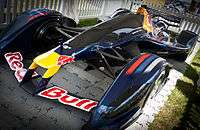Red Bull X2010

The Red Bull X2010 (originally named Red Bull X1) is a fictional prototype vehicle featured in the PlayStation 3 video game Gran Turismo 5. It reappeared in Gran Turismo 6. The Red Bull X2010 appeared on the Goodwood Festival of Speed and in Madrid.[1] The digital creation was a response to Kazunori Yamauchi's question: "If you built the fastest racing car on land, one that throws aside all rules and regulations, what would that car look like, how would it perform, and how would it feel to drive?".[2] The Prototype was designed by Red Bull Racing Chief Technical Officer Adrian Newey in conjunction with Yamauchi. It features enclosed wheels, and a "fan element" to increase low and medium-speed downforce (much like a Chaparral 2J or Brabham BT46B).
Overview
The X2010 was theorised by Adrian Newey, head engineer of Red Bull Racing, and Kazunori Yamauchi, and features exclusively in Gran Turismo video games. The hypothetical car, designed as an ultimate racing machine, was designed with pure speed in mind, rather than adherence to rules and regulations. It is theoretically superior to a Formula One car in terms of speed and handling.
Initially the concept of the X2010 was based on a low air resistance, single seater covered wheel prototype, a wing car powered by a forced induction engine producing 1479 HP,[3] aiming to achieve a top speed of over 470 km/h (292 mph) (max of 494 km/h whilst using slipstreams in the game) and a maximum lateral G-force of 6g. Upon seeing the machine's concept and design model, Newey proposed the addition of fan car technology, a long-time dream held as a racing designer.
The benefit of a fan car is that it pulls air out from underneath the car, creating an area of comparatively lower pressure. This difference in pressure above and below the car presses it towards the ground, producing downforce. The fan principle allows the X2010 to maintain a high cornering speed in low speed corners.
After the evaluation of the technology going into the car, the X2010 was redesigned incorporating refinement advice from Newey. With its low air resistance achieved through its smooth glass canopy and full cowling over the tyres, and the downforce gained from the low speed range using the fans as well as in the high speed range through the front and rear wings and the rear diffuser, the car ultimately achieved a theoretical maximum speed of 500 km/h, a weight of 545 kg, and a maximum lateral G force exceeding 8G. This spec is virtually at the very limit of what a normal human body can withstand.
The driver who performed the virtual shakedown test of the car was Red Bull Racing driver Sebastian Vettel. On his first run, he shortened the simulated course record held by Formula 1 cars on GT5's simulation of the Suzuka Circuit by over 20 seconds, drawing out the theoretical potential of the X2010 machine.[4]
Due to its great speed and cornering, possession of the car makes simulator progress much easier, and because of this, it became a much sought after model soon after Gran Turismo 5's release. In the United States, virtual copies of the car were on sale on the auction website eBay for $250.[5]
Later versions
The version 2.0 update to Gran Turismo 5 features an updated version of the car, the X2011, featuring a larger rear wing and a higher top speed. A slightly de-tuned and fanless, but bigger wing version of the X2010, called the X2010 5G, was only offered in Japan in part of the Red Bull 5G competition series which was held in Japan.
Updated versions of the car, the X2014, with and without fan technology, appear in Gran Turismo 6.[6] A model was shown at Autosport International 2014.[7]
In other media
In September 2012, it was announced that AUTOart would be producing a 1:18 scale version of the car.[8] The model was released in a range of colours in 2013 and sold out. In 2016, the same company released a model of the X2014, available in three colours.[9]
Notes
- ↑ http://www.f1fanatic.co.uk/2011/01/12/adrian-newey-on-the-red-bull-x2010/
- ↑ "Gran Turismo 5′s Red Bull X1 Prototype Revealed (w/Specs!)". Gtplanet.net. Retrieved 2012-09-19.
- ↑ "Vettel nails the Red Bull 'X1' - BBC Top Gear". Topgear.com. 2010-11-01. Retrieved 2012-09-19.
- ↑ Car Magazine. "Red Bull X1 Supercar 2010", "Car Magazine", 28 October 2010 14:50, accessed 9 December 2010.
- ↑ http://www.jvn.com/jeux/articles/gran-turismo-5-l-arnaque-ebay-de-la-red-bull-x1-a-250.html
- ↑ "Inside Polyphony Digital's Tokyo Offices: Video & Photos". GTPlanet.net. 2013-09-28. Retrieved 2013-11-30.
- ↑ http://carwitter.com/2014/01/21/autosport-2014-review/
- ↑ http://www.gtplanet.net/red-bull-x2010-118-scale-models-to-be-produced-by-autoart/
- ↑ http://www.gran-turismo.com/gb/news/00_3767740.html
External links
| Wikimedia Commons has media related to Red Bull X2010. |